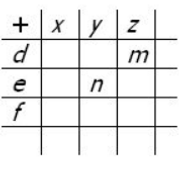Forum Home > GMAT > Quantitative > Problem Solving (PS)
Events & Promotions
| Last visit was: 06 Oct 2024, 03:01 |
It is currently 06 Oct 2024, 03:01 |

Customized
for You
Track
Your Progress
Practice
Pays
09:00 AM PDT
-12:00 PM PDT
01:30 PM IST
-11:30 PM IST
10:00 AM EDT
-11:00 AM EDT
10:00 AM EDT
-11:00 AM EDT
11:00 AM IST
-01:00 PM IST
Difficulty:


 15%
(low)
15%
(low)
Question Stats:
77% (01:20) correct 23%
(01:36)
wrong
23%
(01:36)
wrong  based on 1459
sessions
based on 1459
sessions


addition_table.png [ 6.07 KiB | Viewed 50149 times ]
IMG_20180219_150305.jpg [ 15.2 KiB | Viewed 50057 times ]

|
|
|
Announcements
SUNDAY Quizzes! GRE Quiz @9:30am ET & GMAT Quiz @10:30am ET
Applying to Masters in Management? Join Top MiM Applicant Discussions
Tuck at Dartmouth
|